
From June 1932, air mail was accepted from New Zealand for Africa. It was carried to Karachi by surface mail and flown from there.
A special purple cachet was applied on the first acceptance from Auckland on 30 June and a green cachet on the first acceptance from Wellington on 15 July.
From Auckland
The first mail was sent Auckland - Sydney on the Makura on 30 June - 4 July. It then went by rail to Perth and was sent on the Mooltan from Fremantle to Colombo on 11 - 20 July. From Colombo it was carried by surface to Karachi. The air route from Karachi involved a connection between the Karachi - London and the London - Cape Town routes which, since October 1931, had separated at Athens.
The Karachi to Tiberias leg of the India - London route was flown by the new HP 42 airliners [2]. The mail left Karachi on 27 July and was flown to Jask. On 28 July, it was flown from Jask to Basra and on 29 July to Baghdad and Tiberias (Galilee).
At Tiberias, the mail for London was unloaded and flown to Athens by Kent flying boat. However, as the HP 42s were based in Cairo, a Tiberias to Cairo link service via Ramleh had been set up and so the mail for Africa remained on the plane at Tiberias and was flown from there to Cairo on 30 July.
To Luxor, Egypt
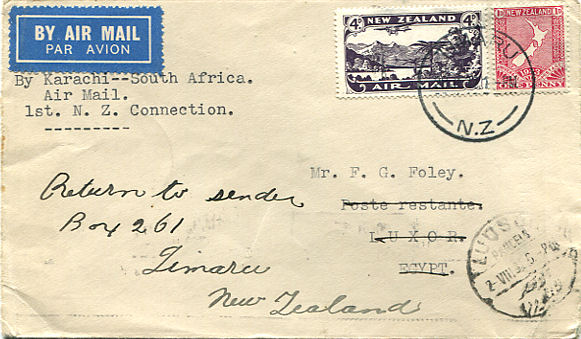
This cover is addressed to Luxor and was backstamped in Cairo on 30 July. At Cairo, the mail joined the London - Cape Town service on 31 July and was flown to Aswan via Asyut and Luxor on 31 July by an AW Argosy.
The cover is backstamped on arrival in Luxor on 31 July although the spelling of Luxor is strange, perhaps Luqsor.
Mail for Sudan onwards had a first flight cachet applied in Auckland, but that was not applied on mail to Egypt.
The air mail fee was 4d in addition to the surface fee of 1d.

A very quick decision was made to return the cover to sender as it has a second Luqsor datestamp on 2 August and a Port Said backstamp on 3 August. Port Said is at the northern end of the Suez Canal and the cover would be sent from there by ship to Fremantle on its way back to New Zealand.
The Oronsay arrived at Port Said on 3 August bound for Fremantle and
so may have carried the cover.
Its mail arrived in Sydney on 28 August.
The Maunganui sailed from Sydney to Auckland on 2 - 6 September
and so that gives a possible date for when the cover arrived back in New Zealand.
To Belgian Congo
The mail was flown from Aswan to Khartoum by the AW Argosy on 1 August. From Khartoum, the mail was flown by a Short S8 Calcutta flying boat to Juba in Sudan on 2 August.
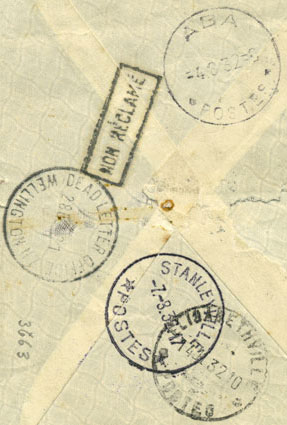

This cover is franked with 1/1½d which suggests that it was made up of 11d airmail surcharge plus 2½d surface postage to a foreign country.
However, although the airmail rate to Sudan was only 4d, the dates suggest that the cover was offloaded at Juba on 2 August and carried by surface to Aba in the Belgian Congo where a transit mark was applied on 4 August. From there it went by surface to Stanleyville where it was backstamped on 7 August. It made very good progress from Juba to Stanleyville as it arrived there on the same day as the airmail arrived in Capetown.

The cover is obviously philatelic in nature as it was both sent by and is addressed to the well known New Zealand aero-philatelist Alex Paterson.
It has a Non reclame cachet on the back and a Retour a l'envoyeur and a REBUT cachet on the front along with a red Retour in manuscript. There is a second Stanleyville postmark on the front dated 25 October and an Elisabethville transit mark on 14 November suggesting that its return journey was via South Africa. Finally, there is a Wellington dead letter office on 28 December, six months after it had been posted. The return from South Africa to New Zealand would be by sea.
Starting in the October 1932, Imperial Airways offered an airmail service
from Belgium to the eastern Begian Congo as can be seen by this advertising poster stamp.
I have seen an auction cover from Brussels to Elisabethville via Broken Hill
postmarked 4 October 1932 with this poster stamp attached.
To Uganda
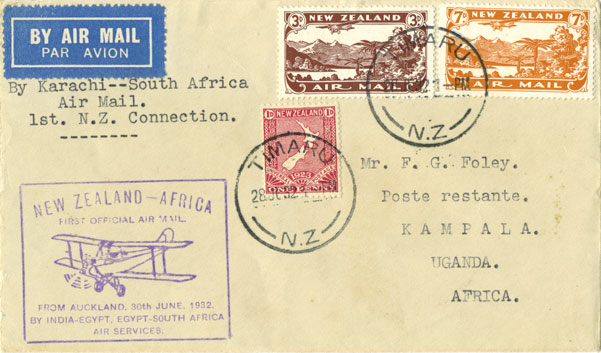
The flight from Juba to Kisumu (Kenya) via Port Bell (Uganda) was on 3 August.
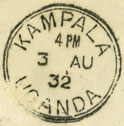
This cover was off-loaded at Port Bell on 3 August and taken to Kampala where it was backstamped at 4pm on 3 August. According to Walker [1], mail for Uganda was backstamped in Cairo on 30 July, but this cover does not have that backstamp.
The airmail rate for Kenya, Uganda and Tanganyika was 10d in
addition to the ordinary rate of 1d and so this cover has the correct
franking.
There were 175 acceptances from New Zealand for Sudan, Kenya, Uganda
or Tanganyika.
To Northern Rhodesia
On 3 August, the mail was transferred from the Calcutta flying boat to a DH 66 and flown from Kisumu to Nairobi. On 4 - 5 August, the mail was flown to Salisbury in Southern Rhodesia.
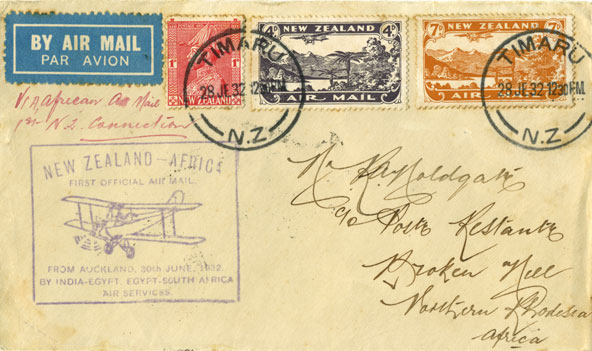

This cover was off-loaded on 5 August at Broken Hill in Northern Rhodesia (now Zambia) where it was backstamped at 4pm.
The airmail rate to Zanzibar, Northern and Southern Rhodesia, Nyasaland and Portuguese East Africa was 11d in addition to the ordinary rate of 1d.
Many of the covers flown on this service were philatelic with the intention that they would be returned to the sender. The above cover has a second backstamp dated 11 October indicating when it started on its return journey.
There were 202 acceptances from New Zealand for Rhodesia or Nyasaland.
To South Africa

The mail was flown from Salisbury to Johannesburg on 6 August and on to Cape Town on 7 August.
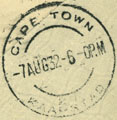
This cover was backstamped in Cape Town at 6pm on August 7.
The airmail rate to South Africa and South West Africa was 1s 1d with an extra 1d for surface postage. The cover has the correct postage of 1s 2d.
There were 153 acceptances from New Zealand for South or South West Africa.
Like the cover to the Belgian Congo, this cover was sent by and to Alex Paterson.
To Khartoum
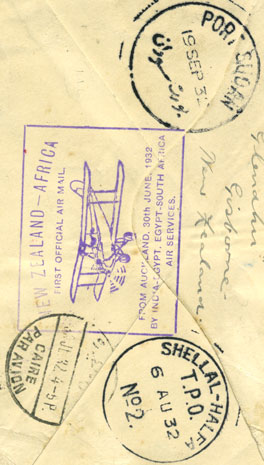
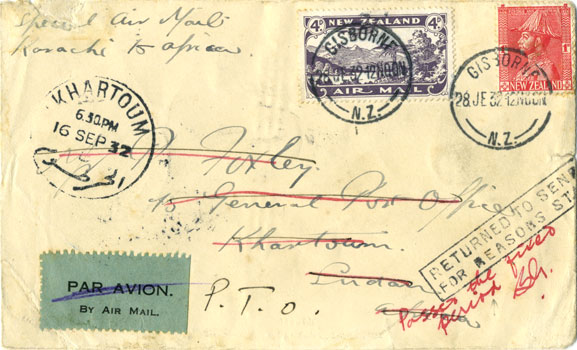
The following cover is one of only 48 acceptances from New Zealand to Khartoum in Sudan. The postage rate was 4d airmail plus 1d surface.
It was flown from Karachi to Cairo as described above. At Cairo it was backstamped Caire Par Avion on 30 July. According to Walker [1], the mail for Egypt, Sudan, Uganda and Kenya was backstamped at Cairo on 30 July.
Although the flight from Cairo arrived in Khartoum on 1 August, the cover has a travelling post office transit mark Shellal - Halfa TPO dated 6 August. This means that the cover was carried by rail from Shellal (near Aswam in Egypt) to Wadi Halfa in Sudan.
A possible explanation is that the Khartoum mail was offloaded by mistake at Aswam [1]. It was then left for several days before being sent by rail to Wadi Halfa where it was picked up by the next flight a week later and flown to Khartoum.
Return from Khartoum
Most, if not all, letters from New Zealand to Khartoum were philatelical. It was common for collectors to send letters on first flights addressed to themselves c/o The Post Office with instructions that if they were not picked up then they were to be returned to the sender.
That is the case with the above cover. However, it has several interesting features concerning the return.
- Par Avion is scored out to indicate that the airmail part of the journey was over.
- There is a cachet Returned to sender for reasons stated and an associated initialled manuscript in red Passed the fixed period.
- There is a Khartoum postmark dated 16 Sep indicating that it was held at the Post Office in Khartoum for 40 days before the decision was made to return it.
- It was backstamped at Port Sudan on the Red Sea on 19 Sep showing the start of the sea route taken on the return journey.
There is no indication of when it eventually arrived back in New
Zealand.
From Wellington
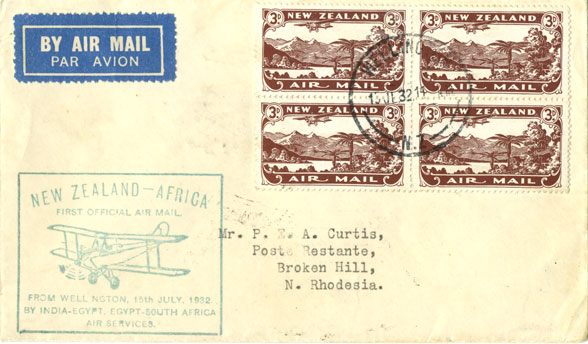
The next cover was sent on the first acceptance of mail from Wellington which was carried from Wellington to Sydney on the Maunganui on 15-19 July. It has a special cachet in green. From Sydney it was sent to Perth by rail and then went from Fremantle to Colombo on the Corfu on 25 July - 3 August.
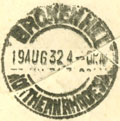
It was flown from Karachi to Cairo on 11 - 13 August [2]. It was then flown from Cairo to Halfa on 14 August, to Khartoum on 15 August, to Juba on 16 August, to Kisumu on 17 August where the mail was transferred from the Calcutta flying boat to a DH 66 Hercules before being flown on to Nairobi.
From there it was flown on 18 August to Mbeya and on 19 August to Broken Hill (Northern Rhodesia) where this cover was off-loaded and backstamped.
The total number of acceptances from Wellington to all destinations
was only 256.
Of these, 55 were for Kenya or Uganda and 46 for Rhodesia or Nyasaland.

This cover is one of the 155 acceptances for South Africa. It is postmarked Auckland on 6 July and was taken from there to Wellington where the green Wellington cachet was applied on the back of the cover.
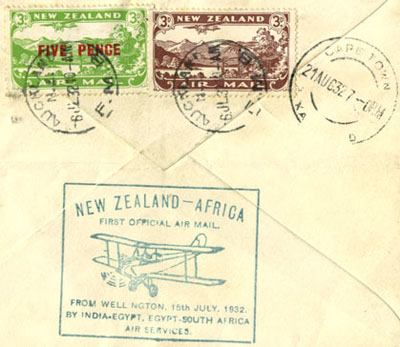
The route to Broken Hill is described above. The cover was then flown from Broken Hill to Salisbury on 19 August and on to Johannesburg on 20 August and to Cape Town on 21 August.
The postal rate was 1d surface plus 1s 1d per ½oz airmail surcharge. This cover is franked with 1s 7d on the front and 8d on the back giving a total of 2s 3d in stamps.
It must therefore have weighed more than ½oz and so the franking is 1d plus twice the airmail surcharge.
It was backstamped on arrival in Capetown on 21 August.
India - South Africa
The first regular London - South Africa airmail had left Croydon Airport on 20 January 1932. Although mail was not accepted for this flight from New Zealand, mail was accepted from India.
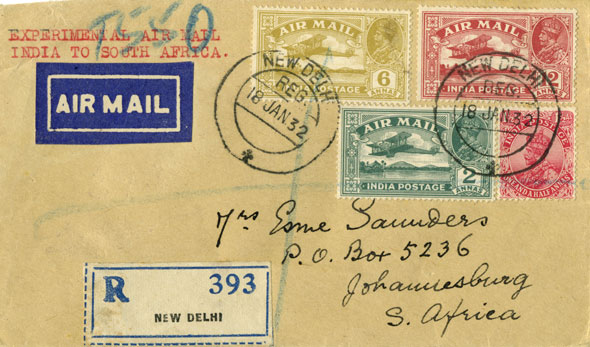
The example cover is postmarked New Delhi on 18 January 1932. From the beginning of 1932, the Delhi - Karachi leg was no longer flown by IA, but by the Delhi Flying Club.
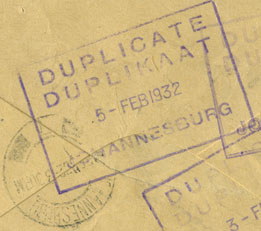
The mail was then flown by Imperial Airways from Karachi on the India - London service on 20 -22 January to Tiberias where the London mail was off-loaded. According to Wingent [2], the plane was Hadrian, an HP 42.
The mail for Africa remained on the HP 42 and was flown to Cairo on 23 January to join the London - Cape Town service. The mail arrived in Johannesburg on 1 February and in Cape Town on 2 February.
As well as having a Johannesburg backstamp, the shown cover
has three DUPLICATE DUPLIKAAT backstamps dated in turn 3, 4 and
5th February.
There were 40 acceptances of mail from India to Johannesburg on the first flight.
All scans were made by the author.
Information on this page is taken from:
[1] Airmails of New Zealand, volume 2 (1986) compiled by
Douglas A Walker published by the
Air Mail Society of New Zealand.
[2] Aircraft Movements on Imperial Airways' Eastern Route,
Vol 1, 1927 - 1937, Peter Wingent, Winchester 1999.